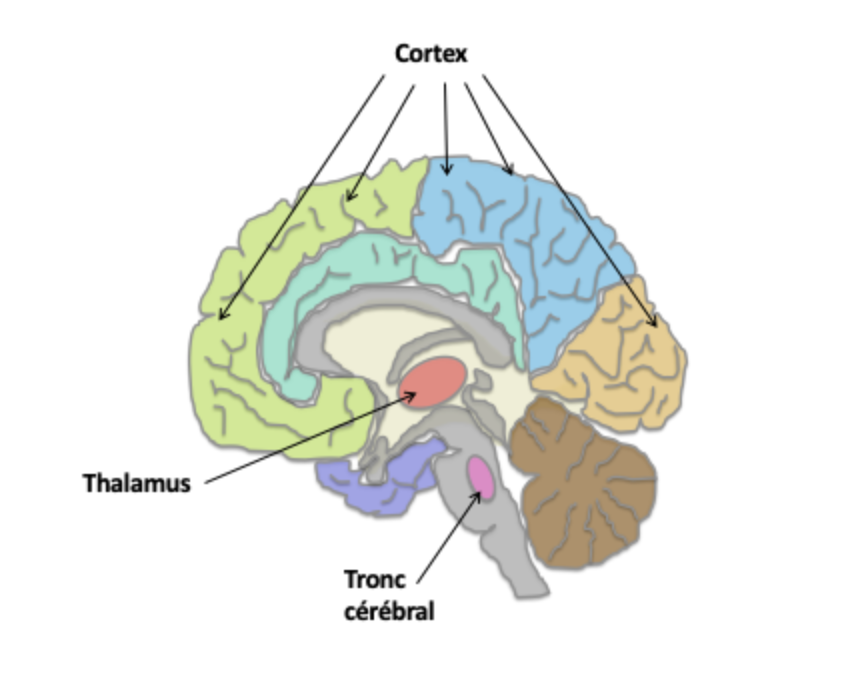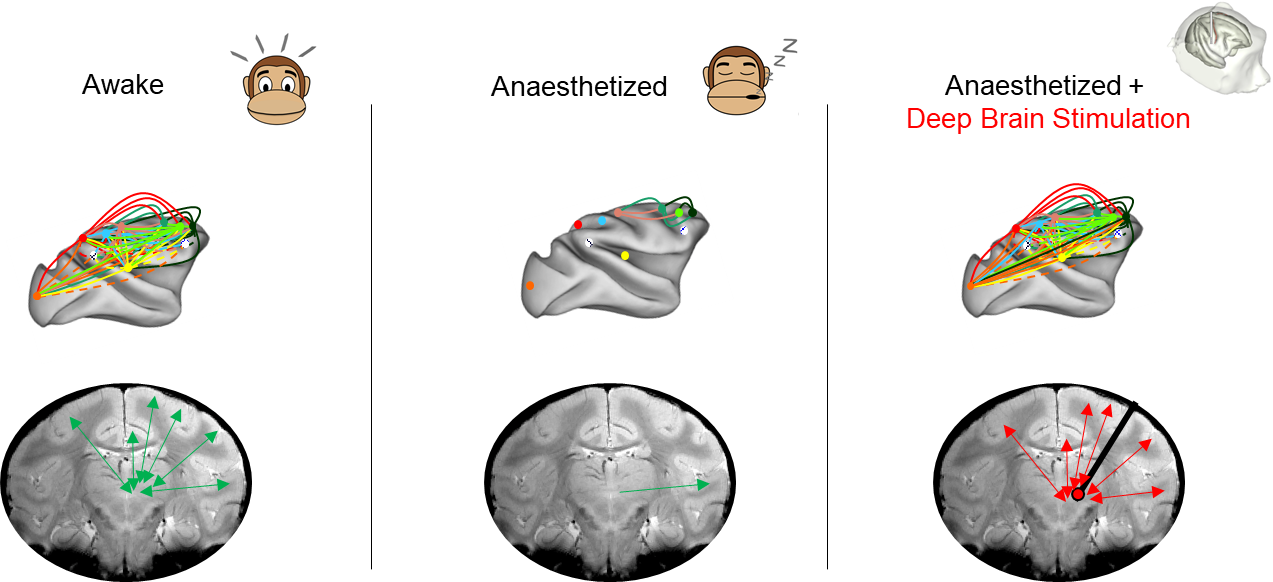Two levels of consciousness
Consciousness is a dynamic and complex process that requires the
coordination of activity from distant regions of the brain. Neuroscientists agree that there are at least
two hierarchical levels of consciousness. The first one corresponds to
arousal (awake, asleep...). It is linked to the
activation of very deep brain structures located in the brain stem. The second reflects our ability to access information from the world around us (we speak of
conscious access). This conscious access corresponds to a coding of the perceived information by the simultaneous activation of groups of neurons distributed in different areas of the cortex.

Scheme of the anatomy of the brain with the location of the 3 structures involved in the two levels of consciousness: the cortex, the brain stem and the thalamus. © B. Jarraya / UVSQ
A way to restore awarness?
A link has been established between loss of consciousness and a strong disruption of long-distance communication between different areas of the cortex and between the cortex and the thalamus (a region of the brain halfway between the brainstem and the cortex). Brain imaging studies suggest that restoring these communications may be the key to recovery from chronic disorders of consciousness. In particular, several teams around the world have shown that an anesthesia-induced loss of consciousness can be reversed by direct manipulation of the thalamus. In particular, Deep Brain Stimulation (DBS) specifically targeting the thalamus can modulate arousal in anesthetized rodents or non-human primates and improve behavioral aspects in patients with consciousness disorders by restoring global cortical activity. However, a clear demonstration that DBS can restore both aspects of arousal and conscious access is currently lacking.
A model
Béchir Jarraya's team[1] at UNICOG (NeuroSpin department) has previously developed a non-human primate model of loss of consciousness based on anesthesia. In this model, using functional MRI and electroencephalography, the team demonstrated a signature of the state of general anesthesia: the matrix of functional connectivities is much less complex and dynamic in an anesthetized subject than in an awake subject (The discovery of a universal cerebral signature of anesthesia). In collaboration with an ICM team, it also revealed the existence of a signature of conscious access: when a subject is made to hear a regular sequence of sounds and this is disturbed (auditory violation), a global activation of an extensive cortical network is detected if the subject is awake but not if he is anaesthetized. These two signatures have also been identified in humans (functional MRI: a powerful tool for assessing states of consciousness).
In a new paper published in Sciences Advances, the team investigated the potential of thalamic DBS to restore these two signatures of consciousness in deeply anesthetized non-human primates.
During anesthesia, stimulation of the central thalamus induced arousal and increased activity detected by functional MRI in prefrontal, parietal, and cingulate cortex. Discontinuation of the stimulation immediately returned the subject to a state of deep sedation. In addition, DBS restored a large dynamic repertoire of spontaneous resting-state activity, previously described as a signature of consciousness. None of these effects were obtained when stimulating a control site in the ventrolateral thalamus. Finally, DBS restored a broad hierarchical response to auditory violations that had been disrupted under anesthesia.
Schematic representation of the functional connectivities between different areas of the cortex (top line) and between the cortex and the thalamus (bottom line) in three situations: awake animal, anesthetized animal, anesthetized and treated with DBS. © B. jarraya / UVSQ
Thus, DBS restored both dimensions of consciousness, arousal and conscious access, after loss of consciousness. It paves the way for future clinical trials of consciousness restoration in patients with chronic disorders of consciousness, after severe head injury or stroke.
CEA-Joliot researcher contact:
Béchir Jarraya (bechir.jarraya@cea.fr)